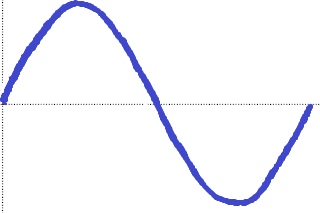(The following is my latest writing regarding the Hi-Res vs CD format. As you guys are knowledgeable in audio science, I would like to see if you have any comment about it. Thanks)
What's the difference between CD-quality music and Hi-Res music.

Some people on various on-line audio science forums claim that "Hi-Res is useless" and "you cannot hear the difference between the CD-quality music and Hi-Res music".
You may ask, "Really? Is Hi-Res music really useless?"
Well. Let's check together with our critical thinking!
(
note: this is a
high level comparison between CD-Quality format and Hi-Res format. It should give you a good starting point for your own investigation)
Reconstruct music from CD-quality format
The following graph (
Figure 1) shows the original analog input signal (a perfect sine wave)
.png) Figure 1:
Figure 1: Original analog input signal (a perfect sine wave
As the final audio signal reconstruction process can
never be perfect, the reconstructed analog signal looks like a "smooth" sine wave but, in fact, it is smeared due to
16-bit quantization and other artifacts introduced during the ADC and DAC process as shown on
Figure 2 below:
(note: in Monty's video, it claims that "the analog signal
can be reconstructed "
losslessly, smoothly, and with the exact timing of the original signal [
by using CD fromat]" which I disagreed)
 Figure 2:
Figure 2: the reconsturcted sine wave is smeared due to
16-bit quantization and other artifacts introduced in the ADC and DAC process (simulated to show the effects of reconstruction artifacts).
Note 1: Sorry for my poor hand-drawing, the graph should be a "smooth" sine wave with smearing.
Note 2: the level of smearing may
not be in scale with the actual output from a DAC with "perfect" filter as the above graph is for indicating the effects of artifacts in the reconstruction process)
Note 3: Dithering is one of the source of the smearing.
Does Hi Res help to reconstruct better music?
Let's look at the following graph (
Figure 3) that shows the ouput of the
same analog input signal. (The graph is a simulated graph with 24-bit quantization. The smearing is reduced due to
24-bit quantization. As you can see here, the degree of smearing is less than the one shown on Figure 2 for CD-quality format).
 Figure 3:
Figure 3: the reconsturcted sine wave is smeared due to
24-bit quantization and other artifacts introduced in the ADC and DAC process (simulated to show the effects of reconstruction artifacts). The degree of smearing is much less than the one with 16-bit quantization that is used by the CD-quality format.
Note 1: Sorry for my poor hand-drawing, the graph should be a "smooth" sine wave with less smearing than the 16-bit version.
Note 2: the level of smearing may
not be in scale with the actual output from a DAC with "perfect" filter as the above graph is for indicating the effects of artifacts in the reconstruction process
Note 3: Dithering is one of the source of the smearing.
Why Hi-Res has less smearing when compared with CD-quality format?
For Hi-Res, there are 16,777,216 different levels (24-bit) to digitize the amplitude of the analog input signal;
For CD format, there are only 65,536 different levels (16-bit) to digitized the amplitude of the same analog input signal (i.e. Hi-Res is 256x better than CD format in terms of number of levels for digitizing the amplitude of the analog input signal).
Which one you need? CD format or Hi-Res?

It all depends on if you can hear the difference between the reconstructed audio signal in Hi-Res format (the blue one with smearing) and the one in CD-quality format (the red one with worser smearing).
If you cannot hear the difference, CD format would probably be good enough for you. However, if you can hear the difference, Hi-Res would help your system to reconstruct better final audio output for your enjoyment.
No matter what format you use, enjoy your good music and let's debunk pseudo science together with our critical thinking. Yeah!

































 .....
.....

.png)







